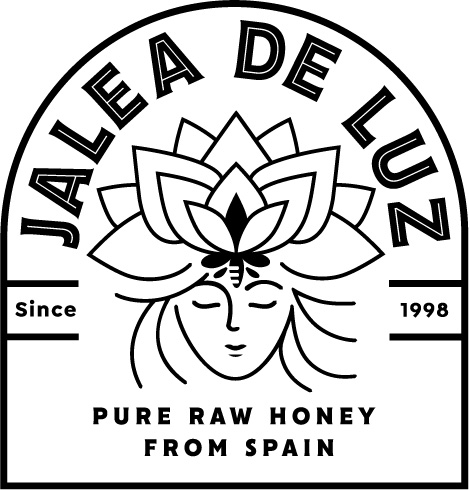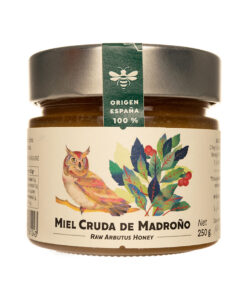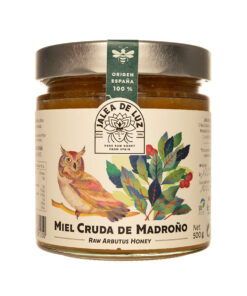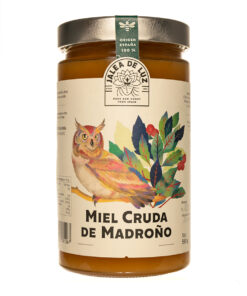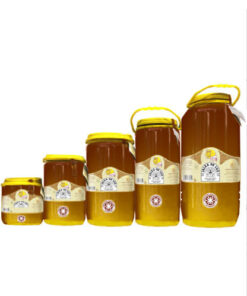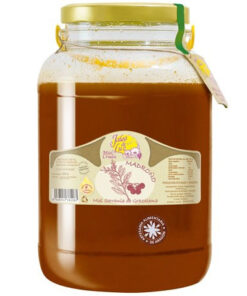Arbutus Honey
Origin : Spain and other areas of the Iberian Peninsula.Representative species: Arbutus Tree (Arbutus unedo).
Main floral composition: Arbutus Tree (Arbutus unedo) and varied native wild Flora.
Production period: Autumn - Winter.
Color : Amber Brown to dark amber.
Taste : slightly acidified bitter.
Aroma : penetrating, consistent and unique.
Peculiarities: raw honey, pure, not homogenized, not filtered, without added sugars.
Conservation : keep dry, semi-dark and cool.
** In its natural process, honey crystallizes and hardens according to various parameters (temperature, floral origin, etc..).
Characteristics of Arbutus Honey
Its unique bitter taste with tiznes evocative to sensations of rust in the first instance (slightly acidulated), is subtly delicate shortly after its tasting, making it an easily recognizable natural honey. Its peculiar bitter taste is due to a hodgepodge of components such as heterosides, arbutin, tannins,.. that bees process to produce this exquisite Honey, Queen of winter beekeeping.Usually fast crystallization in thick grains, it has a unique texture, granular and pleasant to the palate. It shows a color that evolves from Amber Brown when solidifying, to acquire a darker tone when it is in a more fluid state.
Its aroma is penetrating, consistent and unique.
It is for these reasons, a honey highly appreciated in Arab cultures for use in traditional culinary recipes or in cosmetic use.
Excellences of Arbutus Honey
Pure natural honeycomb honey that like the rest of our range of honeys and beehive derivatives (pollen, propolis, royal jelly..), is collected by our bees in the traditional craft way, satisfying all the healthy requirements of a natural product excelso:• Raw: never subjected to processes of overheating (more than 40 º) and /or pasteurization, preserving pure all vitamins, nutrients and enzymes, as well as their essential taste and olfactory qualities.
• Unfiltered: in this way, we guarantee all the natural qualities of origin, thus achieving an excellent natural product of First Order.
• Pure: it is produced by bees releasing pollen and nectar from flowers, and secretions of sucking plants and insects, transforming it and then storing it in the honeycombs inside the hive; it is therefore a natural process free of foreign factors that may alter its purity
• No added sugars: our honey is what it is, just as the bee produces it inside the hive, containing only natural sugars typical of unadulterated natural honey.
• Non-homogenized: natural honeys from different geographical or floral origins are never mixed, maintaining unique and individual batches of handling and packaging, because our permanent objective is to maintain the essence and purity from its origin to the palate of the final consumer, in order to make available to you all the attributes that a pure honey can provide
Usage tips
The natural honeys of Arbutus tree, collected by our bees have unique qualities, so it is advisable to take them directly, savoring them in your mouth as long as possible before eating. To make them more manageable in those cases that are preferred diluted, it is recommended at most, warm the "bain-marie" to temperature that never exceeds 40 º to avoid the loss of natural attributes.Conservation tips
Keep in a dry, semi-dark and cool place to keep intact in a natural way all its natural qualities.Arbutus Honey, where does it come from?
This exquisite pure handmade honey, is produced by bees as a result of libation to extract pollen and nectar from the flowers of the Arbutus tree (Arbutus unedo) and native wild flora varied from Serrano forest, adding to this sweet floral composition, resinous substances several of shrubby or tree species, which are collected by the pecoreadoras of the hive.Peculiar shrub /persistent leaf tree up to 4 to 7 m tall, has Vermilion trunk, grayish Ramage, green lanceolate leaves bright by the beam, flowers grouped in inflorescences like hanging panicles and typical fruit of bitter taste in the form of globose Berry reddish maturity, provided with tiny angular seeds dark brown.
Its usual natural environment, is formed by mixed forest located in ravines and river canyons, slopes, holm oak, rock, to crown higher altitudes (800-1200 m), adapting well to silty and stony soils.
Arbutus Honey, etymology and History
Of unknown etymology, many assumptions have been made without a firm foundation on the cradle of the word madroño. Perhaps it comes from the pre-Roman voice "motŏrŏnuu “and with it variant of” morttŏnu", but its natural origin remains a conjecture. There are clearer references in the time of Al Andalus, but all of them are nomenclatures that have been going on over the centuries without a definite root.It has its botanical origin in the Mediterranean basin, covering various territories from Palestine to the Iberian Peninsula, although it can also be found in central America.
In the Roman Empire, the Arbutus tree was a sacred tree or shrub, dedicated to the nymph Cardea or Carna, which protected the entrance of homes, also using its branches in funeral rites. By the year 400, because of the appreciation that had to the Iberian Roman Peninsula Pope Leo I The Great, he ordered this plant a multitude of Arbutus trees as a sacred tree, many of them being eliminated during the Muslim invasion for religious reasons. Greek mythology quotes the legend about the peculiar tree that was born from the blood of the giant Gerion, defeated by Hercules, whose fruit without bones matured at the time when the Pleiades come out; likewise, flutes were made with the wood of its trunk.
In rural Spain of the eighteenth century, the inhabitants used the seeds of Arbutus tree to catch birds during the winter.
The most recognizable symbol in Spain is the osa supported on the madroño in the coat of arms of Madrid, in reference, it is believed, to the attempt to unify the interests of two landowners of estates, in which in some the Woodland predominated and in others the pasture, already several centuries ago.
Its wood was used throughout history to make tools, arches, poles, logs and coal.
Recipes with Arbutus Honey
vegetable omelette with Arbutus HoneyFirst, cut into thin strips half Italian pepper, a quarter sweet onion, a quarter eggplant and 40 grs mushroom.
Then beat 5 egg whites and a whole egg, and season lightly with sea salt and a little tarragon .
Heat a pan over medium heat with a tablespoon of virgin olive oil and cook in it the onions cut to caramelize; then repeat with green peppers, mushrooms and eggplant separately. We cut a few strips of tofu that we Cook also slightly in the same way.
Add the vegetables, the tofu, and a grated Aragonese prepirineum cheese, fold the base of the tortilla and wrap everything to cook it over low heat; in the final process, before fully set, add half a tablespoon of Arbutus Honey tea and half of blueberry jams and raspberries, which will bring the counterpoint of flavor inside the pan. from the tortilla; in a minute remove from the pan and let cool.
We toast 2 slices of spelt bread, add a few drops of virgin olive oil, a pinch of organic poppy seeds, another pinch of pollen and accompany with it our vegetable tortilla.
Decorate with two tablespoons of legumes (chickpeas, lentils,..) previously cooked and sprinkled with olive oil, sea salt, apple vinegar and parsley.
Here we have a fabulous breakfast very complete, exquisite aroma and pleasant taste, as an alternative to the lifeguard cereals with milk.
